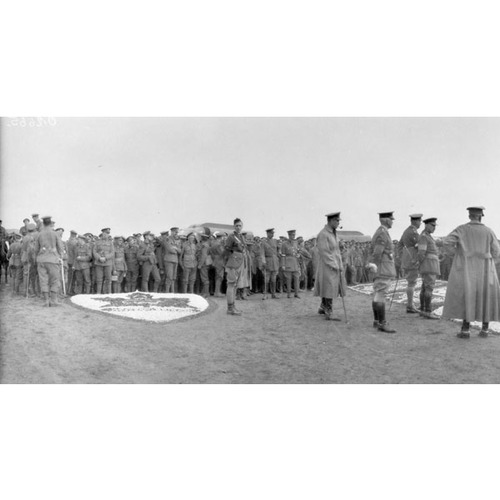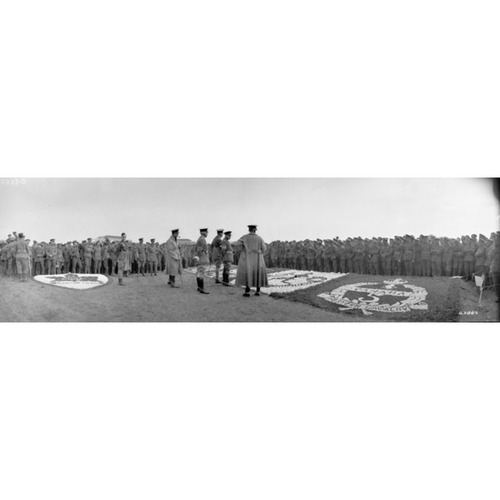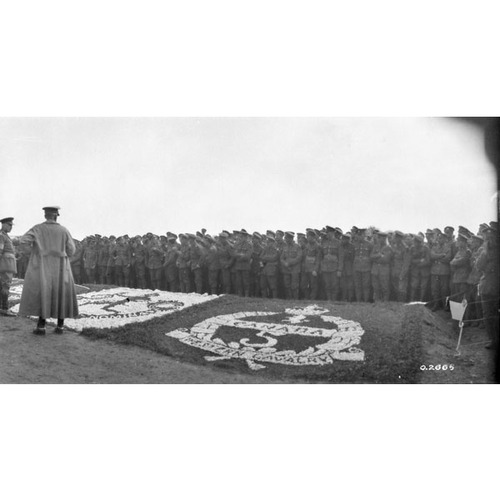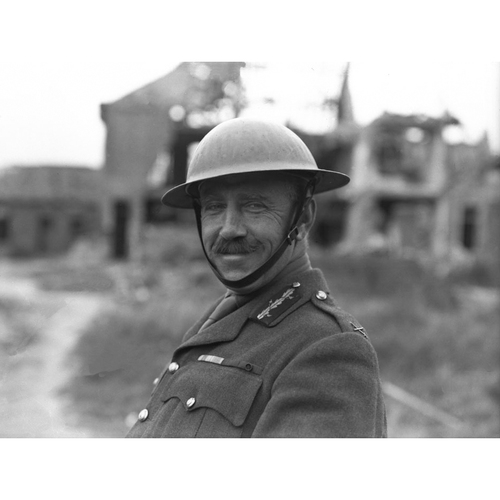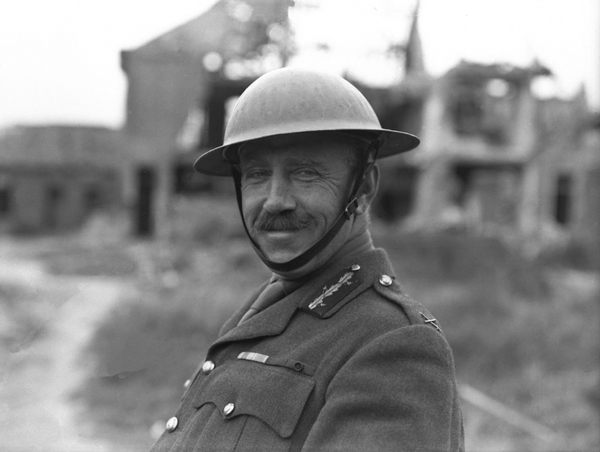
Source: Link
LOOMIS, Sir FREDERICK OSCAR WARREN, businessman and militia and army officer; b. 1 Feb. 1870 in Sherbrooke, Que., son of Daniel Gordon Loomis and Amelia Hall Burrowes; m. 3 Jan. 1894 Margaret Morrison Mundell in Springfield, Mass., and they had five sons and two daughters; d. 15 Feb. 1937 in Montreal.
Frederick Loomis was educated in the public schools of Sherbrooke and at Bishop’s College in nearby Lennoxville (Sherbrooke). In 1891 he joined D. G. Loomis and Sons, which made bricks, sold building materials, and filled contracts for general construction. His partnership with his father and brother lasted until 1912. That year he became sole proprietor of the company, by then an important firm undertaking projects across the country. He had also followed his father into the militia, enlisting as a private in the 53rd (Sherbrooke) Battalion of Infantry at age 16. In 1903, when the family enterprise moved its operations to Montreal, Loomis, then a lieutenant, transferred to the prestigious 5th Regiment (Royal Scots of Canada), which became the Royal Highlanders of Canada three years later. By 1909 he held the rank of major.
When the First World War broke out in August 1914 Loomis was aged 44, a family man, the owner of a prosperous concern, and a leading member of Anglo-Montreal society. Loyally embracing the staunch imperialist convictions of the majority in that community, he promptly enlisted in the Canadian Expeditionary Force. As an officer with considerable experience and connections – and known Conservative loyalties – he soon caught the attention of the minister of militia and defence, Sir Samuel Hughes*. In one of the erratic politician’s more inspired selections he made Loomis a lieutenant-colonel and appointed him commanding officer of the 13th Infantry Battalion. He left Canada in late October.
Loomis established his credentials as a field officer at the second battle of Ypres in April 1915. His unit suffered heavily in the first German gas attack of the war, on 22 April, but under his steady and courageous leadership, it managed to hold the critical ground around Saint-Julien (Sint Juliaan), Belgium, preventing a German advance. Major-General Edwin Alfred Hervey Alderson*, the British commander of the Canadian troops, successfully pressed for his promotion, and Loomis became a brigadier-general in March 1916. After holding two temporary posts, including supervision of a brigade still training in England, he finally got the 2nd Infantry Brigade – recruited from western Canada – in early July. With the exception of three months’ compassionate leave in Canada in early 1918, he served as the 2nd’s commanding officer until September 1918, leading his troops in every major engagement fought by the Canadian Corps during that period – the Somme, Vimy Ridge (where he was slightly wounded), Hill 70, Passchendaele, Amiens, and the Drocourt–Quéant Line. Lieutenant-General Sir Arthur William Currie, the commander of the corps during the last 17 months of the war, considered Loomis one of his best senior officers, writing to Lieutenant-General Sir Richard Ernest William Turner* in December 1917 that “brigadiers like [Loomis] do not grow on gooseberry bushes [and] I would not lose him for the world.” Loomis’s men considered him aloof and stern, but fair-minded and brave.
Among the 2nd Brigade’s singular achievements was the spearheading of the last Canadian attack at Passchendaele on 10 Nov. 1917. As an unidentified Australian officer noted simply, “If the Canadians can hold on, they are wonderful troops.” Hold on they did in the face of fierce enemy efforts to hurl them back, a tribute to their tenacity, but also to their brigadier’s ability to train and inspire them, as well as to feel compassion for their experience with what he described as “the terrible character of modern warfare.” These qualities have been considered by historians as the key to his success as a field commander.
The highlight of Loomis’s career came during what would later become known as the Last Hundred Days campaign. In 1918 Currie had singled out five of his twelve brigadiers as suitable for a divisional command, and picked Loomis to lead the 3rd Canadian Division, which he took over on 13 September. The rapid collapse of the German army permitted Loomis to exercise his new authority in only one major battle, but the thrust across the Canal du Nord, and particularly the crucial forcing of the Marcoing Line east of the canal on 28–29 September, involved some heavy fighting by his men. The war’s end found Loomis in Mons, which his troops entered on the night of 10–11 November. In contemporary pictures and movie footage he can be seen, but is rarely identified, among the senior Canadian officers taking part in the ceremonies marking the town’s liberation.
By 1919 Loomis held all a divisional commander’s expected decorations: he had been made an officer in the Legion of Honour (announced on 30 March 1916), a companion of the Order of St Michael and St George on 4 June 1917, and a knight (kcb) on 3 June 1919. More revealingly, he had also been granted the Distinguished Service Order in 1915, and in 1919 a bar was added. The DSO recognized his actions at the second battle of Ypres, and the bar was for his “gallantry and brilliant leadership” during the opening stages of the fighting at Amiens on 8–9 Aug. 1918 and 3½ weeks later during the main attack on the Drocourt–Quéant Line. In both instances “he [had] made reconnaissances under heavy fire, personally superintending the disposition of troops, and encouraging all by his coolness and ability.”
Worn out by his war service, in May 1919 Loomis happily returned to his business in Montreal and the social life that accompanied it. During the 1920s D. G. Loomis and Sons, in which his eldest son, Daniel McKay, worked as an engineer, specialized in the construction of industrial buildings and hydroelectric power plants. Like many senior Canadian commanders, however, he was roused to action when early drafts of the British army’s official history, which would appear in 1925, seemed to disparage the performance of his troops at second Ypres, as well as the reputation of his friend Currie. Acidly dismissing the assessment as “unfair, unfriendly and ungenerous,” he joined with brother officers to pressure successfully the British authorities for a more acceptable version. In 1928 Loomis unhesitatingly testified on Currie’s behalf when the general launched a libel action, which he won, against an Ontario journalist, William Thomas Rochester Preston*, who had falsely claimed that the corps commander, in ordering the attack on Mons in the last hours of the war, had needlessly sacrificed lives merely to enhance his own reputation.
Frederick Loomis’s business declined significantly during the Great Depression, and his health rapidly deteriorated during the 1930s. He died of heart failure after a brief illness.
Despite a long and successful career in business, Sir Frederick Loomis is best remembered for his military service to Canada during the Great War. With only his pre-war militia experience to draw on, he became one of the Canadian Corps’s ablest and most respected leaders, noted for displaying compassion towards his men and for bearing the heavy responsibilities of command with dignity.
BANQ-E, CE501-S84, 10 Feb. 1874. LAC, R2422-0-8, vol.8, file 51; RG150, Acc. 1992-93/166, box 5736-3. Mass., Office of the Secretary of State, Arch. Div. (Boston), record of marriage, 3 Jan. 1894. National Arch. (G.B.), CAB 45/156. P. H. Brennan, “Byng’s and Currie’s commanders: a still untold story of the Canadian Corps,” Canadian Military Hist. (Waterloo, Ont.), 11 (2002), no.2: 5–16. D. G. Dancocks, Sir Arthur Currie: a biography (Toronto, 1985). Directory, Montreal, 1891–1937. The Distinguished Service Order to the Canadian Expeditionary Force and Canadians in the Royal Naval Air Service, Royal Flying Corps and Royal Air Force, 1915–1920, comp. D. K. Riddle and D. G. Mitchell (Winnipeg, 1991). R. G. Haycock, Sam Hughes: the public career of a controversial Canadian, 1885–1916 (Waterloo, 1986). G. W. L. Nicholson, Canadian Expeditionary Force, 1914–1919: official history of the Canadian army in the First World War (Ottawa, 1962). D. R. O’Keefe, “A brutal, soul-destroying business”: Brigadier-General F. O. W. Loomis and the question of “impersonal generalship,” in Great War commands: historical perspectives on Canadian army leadership, 1914–1918, ed. A. B. Godefroy (Kingston, Ont., 2010), 87–110 (available online at publications.gc.ca/collections/collection_2010/forces/D2-259-2-2010-eng.pdf). Standard dict. of Canadian biog. (Roberts and Tunnell), 2.
Cite This Article
Patrick H. Brennan, “LOOMIS, Sir FREDERICK OSCAR WARREN,” in Dictionary of Canadian Biography, vol. 16, University of Toronto/Université Laval, 2003–, accessed April 30, 2025, https://www.biographi.ca/en/bio/loomis_frederick_oscar_warren_16E.html.
The citation above shows the format for footnotes and endnotes according to the Chicago manual of style (16th edition). Information to be used in other citation formats:
| Permalink: | https://www.biographi.ca/en/bio/loomis_frederick_oscar_warren_16E.html |
| Author of Article: | Patrick H. Brennan |
| Title of Article: | LOOMIS, Sir FREDERICK OSCAR WARREN |
| Publication Name: | Dictionary of Canadian Biography, vol. 16 |
| Publisher: | University of Toronto/Université Laval |
| Year of revision: | 2018 |
| Access Date: | April 30, 2025 |


